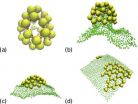(Press-News.org) The missing "lnc" in human disease
LncRNAs (pronounced "link") are long non-coding RNAs that are emerging as important regulators of gene expression in biological processes and diseases. In this issue of the Journal of Clinical Investigation, two papers connect lncRNAs to inherited conditions in humans. Sylvia Bähring and colleagues at the Experimental and Clinical Research Center in Berlin found a chromosomal translocation that disrupts the expression of a lncRNA. This disruption alters the expression of the genes PTHLH and SOX9 and results in brachydactyly, an inherited malformation of the fingers and toes. HELLP syndrome, a group of symptoms occurring in pregnant women that lead to pre-term delivery, was also found to be caused by a lncRNA. Researchers led by Cees Oudejans at the VU University Medical Center in Amsterdam identified a lncRNA on chromosome 12 that activated a set of genes which control the development of the placenta. In a companion commentary, Norman Sharpless of the University of North Carolina at Chapel Hill provides an overview of lncRNA biology and discusses the role of lncRNAs in heritable human diseases.
TITLE:
A misplaced lncRNA causes brachydactyly in humans
AUTHOR CONTACT:
Sylvia Bähring
Experimental and Clinical Research Center (ECRC), Berlin, DEU
Phone: +49 30 9406 2505; Fax: +49 30 9406 2536; E-mail: sylvia.baehring@charite.de
View this article at: http://www.jci.org/articles/view/65508?key=fc9e4db6ede7b299b49b
ACCOMPANYING ARTICLE
TITLE:
HELLP-babies link a novel lincRNA to the trophoblast cell cycle
AUTHOR CONTACT:
Cees Oudejans
VU University Medical Center, Amsterdam, UNK, NLD
Phone: +31-20-4443867; Fax: +31-20-4443895; E-mail: cbm.oudejans@vumc.nl
View this article at: http://www.jci.org/articles/view/65171?key=9d8a7bfbd1e5358f5024
ACCOMPANYING COMMENTARY
TITLE:
Genetic "lnc"-age of Non-Coding RNAs to Human Disease
AUTHOR CONTACT:
Norman Sharpless
UNC-CH School of Medicine, Chapel Hill, NC, USA
Phone: 919-966-1185; Fax: 919-966-8212; E-mail: nes@med.unc.edu
View this article at: http://www.jci.org/articles/view/66645?key=822ef48aa15f78e41113
Reaching the point of no return: early intervention in a mouse model of obesity
Obesity is a chronic metabolic disorder that affects half a billion people worldwide. Managing obesity is difficult, as many patients rebound to their pre-treatment weight. There is a hypothesis that chronic weight gain causes the body to adopt a state that supports excess weight. In a study published in the Journal of Clinical Investigation, researchers led by Malcolm Low at the University of Michigan challenged this hypothesis by developing a mouse model of obesity where the proopiomelanocortin (Pomc) gene in the hypothalamus can be turned on and off. With Pomc turned off, the mice ate heavily and became obese. Low and colleagues turned Pomc back on at different time points after the mice became obese and found that the effectiveness of this genetic rescue declined as the longer the mice stayed obese. In a companion commentary, Joel Elmquist of the University of Texas Southwestern Medical Center discusses the impact of this research on the development of strategies to halt the obesity epidemic.
TITLE:
Obesity-programmed mice are rescued by early genetic intervention
AUTHOR CONTACT:
Malcolm Low
University of Michigan Medical School, Ann Arbor, MI, USA
Phone: 734-647-1350; E-mail: mjlow@umich.edu
View this article at: http://www.jci.org/articles/view/62543?key=5d5330c1f52eae0ce08e
ACCOMPANYING ARTICLE
TITLE:
Tipping the Scales Early: Probing the Long Term Effects of Obesity
AUTHOR CONTACT:
Joel K. Elmquist
UT Southwestern Medical Center, Dallas, TX, USA
Phone: 214 648 2911; Fax: 214 648 5612; E-mail: joel.elmquist@utsouthwestern.edu
View this article at: http://www.jci.org/articles/view/66409?key=f7dc09f6316af5fe9b28
MicroRNA editing mistake underlies invasive brain tumor
MicroRNAs (miRNAs) are short, non-coding RNAs that block the expression of a set of target genes. In the brain, miRNAs in the miR-376 cluster undergo editing. In a study published in the Journal of Clinical Investigation, Shu Wang and colleagues at the National University of Singapore demonstrated that disruption of this editing step enhanced the invasiveness of human gliomas. They found a significant correlation between accumulation of unedited miR-376 and tumor invasion, as measured by MRI in human patients. They then implanted glioma cells in mice that had edited or unedited miR-376 and showed that the glioma cells with unedited miR-376 migrated and invaded more than glioma cells with edited miR-376. In an accompanying commentary, Gideon Rechavi of Tel Aviv University discusses the implications of these findings for the development of therapeutics that target RNA editing.
TITLE:
Attenuated adenosine-to-inosine editing of microRNA-376a* promotes invasiveness of glioblastoma cells
AUTHOR CONTACT:
Shu Wang
National University of Singapore, Singapore, SGP
Phone: 65 68247105; E-mail: swang@ibn.a-star.edu.sg
View this article at: http://www.jci.org/articles/view/62925?key=9bbf924e853fa4c147b5
ACCOMPANYING COMMENTARY
TITLE:
Micro editing mistake translates into a devastating brain tumor
AUTHOR CONTACT:
Gideon Rechavi
The Chaim Sheba Medical Centre, Tel-Aviv, , ISR
Phone: 0097353305943; E-mail: gidi.rechavi@sheba.health.gov.il
View this article at: http://www.jci.org/articles/view/66178?key=67f018c44fd0acd8d498
Close to the bone: metabolic effects of glucocorticoids
Long-term glucocorticoid treatment is associated with many dangerous side effects, including weight gain, insulin resistance, diabetes, and osteoporosis; however, the pathological mechanisms that cause these side effects are not well understood. In a study published in the Journal of Clinical Investigation, researchers led by Tara Brennan-Speranza at the University of Sydney in Australia found that bone-building osteoblasts play a pivotal role in the metabolic effects of glucocorticoids. Disruption of glucocorticoid signalling in osteoblasts inhibited the effects of glucocorticoids on weight gain and insulin resistance in mice. These results suggest that the effects of glucocorticoids on metabolism are mediated, at least in part, by the skeleton. In a companion commentary, C. Ronald Kahn of Harvard Medical School discusses the implications of these findings in the development of therapeutics to combat the side effects of glucocorticoids.
TITLE:
Osteoblasts mediate the adverse effects of glucocorticoids on fuel metabolism
AUTHOR CONTACT:
Tara Brennan-Speranza
ANZAC Research Institute, University of Sydney, Sydney, UNK, AUS
Phone: +61 2 97679163; Fax: +61 2 97679101; E-mail: tara@anzac.edu.au
View this article at: http://www.jci.org/articles/view/63377?key=9750bc3937eb603fd867
ACCOMPANYING COMMENTARY
TITLE:
New Mechanisms of Glucocorticoid Induced Insulin Resistance: Make No Bones About It
AUTHOR CONTACT:
C. Ronald Kahn
Joslin Diabetes Center, Boston, MA, USA
Phone: 617-732-2635; Fax: 617-732-2593; E-mail: c.ronald.kahn@joslin.harvard.edu
View this article at: http://www.jci.org/articles/view/66180?key=0604dbf4c83a533f707e
The unintended consequences of anti-VEGF therapy in retinal disease
VEGF, a protein that mediates blood vessel growth, is a common target of therapies that are directed at controlling vascular abnormalities in cancer and eye diseases such as diabetic retinopathy. VEGF's role in development is well established, but its role in the adult eye isn't well understood. In a study published in the Journal of Clinical Investigation, Martin Friedlander and colleagues at the Scripps Research Institute in La Jolla, California found that removing VEGF from the retinas of adult mice induced vision loss and disrupted blood flow to the outer retina and photoreceptor cells. These results demonstrate that VEGF is necessary for retinal function and suggest that direct targeting of VEGF could cause more side effects than other proteins that modulate blood vessels in the eye. In a companion article, Susan Quaggin of the Samuel Lunenfield Research Institute in Toronto discusses how this research will impact the use of anti-VEGF therapy in retinal diseases.
TITLE:
Targeted deletion of Vegfa in adult mice induces vision loss
AUTHOR CONTACT:
Martin Friedlander
Scripps Research Institute, La Jolla, CA, USA
Phone: 858-784-9138; Fax: 858-784-9135; E-mail: friedlan@scripps.edu
View this article at: http://www.jci.org/articles/view/65157?key=26f4210f38d0caa38940
ACCOMPANYING COMMENTARY
TITLE:
Turning a Blind Eye to anti-VEGF Toxicities
AUTHOR CONTACT:
Susan E. Quaggin
The Samuel Lunenfeld Research Institute, Toronto, ON, CAN
Phone: +1 416 586 4800 ext. 2859; Fax: +1 416 586 5130; E-mail: quaggin@lunenfeld.ca
View this article at: http://www.jci.org/articles/view/65509?key=f73a86be6b28acb3c364
Alerting the lung to low oxygen levels
Hypoxic pulmonary vasoconstriction (HPV) is a physiological mechanism by which the pulmonary arteries redirect blood flow from a low oxygen area of the lungs to a region that is oxygen rich. In a study published in the Journal of Clinical Investigation, Wolfgang Kuebler and colleages at St. Michael's Hospital in Toronto elucidated the molecular mechanisms involved in HPV. In mice, they found that HPV required the gap junction protein connexin 40 and originated with oxygen-sensing in the alveolar capillaries. The low-oxygen signal was then propagated to lung arterioles in a connexin 40-dependent manner. This study identifies connexin 40 as a potential target in the treatment of chronic hypoxic lung disease. In a companion commentary, Jahar Bhattacharya of Columbia University discusses how this research alters our current understanding of HPV.
TITLE:
Hypoxic pulmonary vasoconstriction requires connexin 40-mediated endothelial signal conduction
AUTHOR CONTACT:
Wolfgang Kuebler
St. Michael's Hospital, Toronto, ON, CAN
Phone: 416 864 5924; Fax: 416 864 5958; E-mail: kueblerw@smh.toronto.on.ca
View this article at: http://www.jci.org/articles/view/59176?key=c2ca0ded3e3aaba58442
ACCOMPANYING COMMENTARY
TITLE:
Lung capillaries raise the hypoxia alarm
AUTHOR CONTACT:
Jahar Bhattacharya
Columbia University College of Physicians & Surgeons, New York, NY, USA
Phone: 212 305-7093; Fax: 212 305-6701; E-mail: jb39@columbia.edu
View this article at: http://www.jci.org/articles/view/65623?key=5e19a363ab2bfa814052
Not so fast: PPARβ/δ slows insulin secretion
Type 2 diabetes is characterized by high plasma glucose levels, insulin resistance, and inadequate insulin production. Insulin is secreted by pancreatic β islets and the number of β islets strongly influences the body's ability to process glucose. In this issue of the Journal of Clinical Investigation, Walter Wahli and colleagues at the University of Lausanne in Switzerland report that PPARβ/δ, proteins that regulate gene expression, are critical mediators of β islet insulin secretion in mice. PPARβ/δ-mutant mice had more β islets and enhanced insulin secretion compared to normal mice. By examining the genes that were expressed in normal and mutant β islets, Wahli and colleagues found that PPARβ/δ repress genes that help β islets secrete insulin. Further, islets lacking PPARβ/δ released insulin more quickly than normal islets, suggesting that therapeutics targeting PPARβ/δ in the pancreas may help stimulate insulin release in diabetic patients.
TITLE:
PPARβ/δ affects pancreatic β-cell mass and insulin secretion in mice
AUTHOR CONTACT:
Walter Wahli
Center for Integrative Genomics, National Research Center Frontiers in Gene, Lausanne, UNK, CHE
Phone: +41 21 692 41 10; Fax: +41 21 692 41 15; E-mail: walter.wahli@unil.ch
View this article at: http://www.jci.org/articles/view/42127?key=8d924abba94838e6f75c
Preventing stem cell-like phenotype makes cancer cells susceptible to immune clearance
Tumor cell adaptation is a major cause of cancer progression. Immune selection drives adaption in human cancers by selecting for tumor cells that evade the immune system. In a study published in the Journal of Clinical Investigation, researchers led by T.C. Wu at Johns Hopkins University report that immune selection drives tumor cells to adopt a stem cell-like phenotype. Using a mouse model of colon cancer, Wu and colleagues showed that blocking the Nanog cell signaling axis prevented tumor cells from developing this phenotype and rendered them susceptible to immune-mediated clearance.
TITLE:
Nanog-Tcl1a-Akt axis-induced tumor stem-like phenotype with immune evasion
AUTHOR CONTACT:
T.-C. Wu
The Johns Hopkins University, Baltimore, MD, USA
Phone: 410-614-3899; Fax: 443-287-4295; E-mail: wutc@jhmi.edu
View this article at: http://www.jci.org/articles/view/64057?key=8f52a8a6b03e55195493
Mobilizing the immune system to protect the kidneys
Immediately after acute kidney injury (AKI), the immune system mounts a response that increases inflammation, causing additional kidney damage. In a study published in the Journal of Clinical Investigation, researchers led by Li Li at the University of Virginia examined the role of the anti-inflammatory molecule adenosine in mediating this immune response. Using a mouse model of AKI, they found that drugs that activate the adenosine 2A receptor (A2AR) protected kidneys and that mice with A2AR-deficient immune cells were more susceptible to kidney injury. Administration of immune cells that had been pre-treated with A2AR-activating drugs was also protective and could serve as a cell-based therapeutic in kidney injury. In an accompanying commentary, Hamid Rabb of the Johns Hopkins University School of Medicine discusses how these findings could impact the development of immune-based therapies for AKI.
TITLE:
Dendritic cells tolerized with adenosine A2AR agonist attenuate acute kidney injury
AUTHOR CONTACT:
Li Li
University of Virginia, Charlottesville, VA, USA
Phone: 1-434-924-2110; Fax: 1-434-924-5848; E-mail: ll3m@virginia.edu
View this article at: http://www.jci.org/articles/view/63170?key=1002f457b47cd938540e
ACCOMPANYING COMMENTARY
TITLE:
The promise of immune cell therapy for acute kidney injury
AUTHOR CONTACT:
Hamid Rabb
Johns Hopkins University School of Medicine, Baltimore, MD, USA
Phone: (410) 502-1556; Fax: (410) 614-5129; E-mail: hrabb1@jhmi.edu
View this article at: http://www.jci.org/articles/view/66455?key=4532dcba81b79b4c3c09
### END
JCI early table of contents for Oct. 24, 2012
2012-10-24
ELSE PRESS RELEASES FROM THIS DATE:
The missing 'lnc' in human disease
2012-10-24
LncRNAs (pronounced "link") are long non-coding RNAs that are emerging as important regulators of gene expression in biological processes and diseases. In this issue of the Journal of Clinical Investigation, two papers connect lncRNAs to inherited conditions in humans. Sylvia Bähring and colleagues at the Experimental and Clinical Research Center in Berlin found a chromosomal translocation that disrupts the expression of a lncRNA. This disruption alters the expression of the genes PTHLH and SOX9 and results in brachydactyly, an inherited malformation of the fingers and ...
Reaching the point of no return: Early intervention in a mouse model of obesity
2012-10-24
Obesity is a chronic metabolic disorder that affects half a billion people worldwide. Managing obesity is difficult, as many patients rebound to their pre-treatment weight. There is a hypothesis that chronic weight gain causes the body to adopt a state that supports excess weight. In a study published in the Journal of Clinical Investigation, researchers led by Malcolm Low at the University of Michigan challenged this hypothesis by developing a mouse model of obesity where the proopiomelanocortin (Pomc) gene in the hypothalamus can be turned on and off. With Pomc turned ...
84 million stars and counting
2012-10-24
Using a whopping nine-gigapixel image from the VISTA infrared survey telescope at ESO's Paranal Observatory, an international team of astronomers has created a catalogue of more than 84 million stars in the central parts of the Milky Way. This gigantic dataset contains more than ten times more stars than previous studies and is a major step forward for the understanding of our home galaxy. The image gives viewers an incredible, zoomable view of the central part of our galaxy. It is so large that, if printed with the resolution of a typical book, it would be 9 metres long ...
A 84-million star color-magnitude diagram of the Milky Way bulge
2012-10-24
Astronomy & Astrophysics published the first analysis of a catalog of 84 million individual stars in the Milky Way bulge as a part of the VVV ESO public survey. This gigantic data set allows building the largest, deepest, and most accurate color-magnitude diagram ever produced, containing more than ten times more stars than any previous study.
The bulge of the Milky Way is a large central concentration of ancient stars that is predominantly observed from the southern hemisphere. Understanding the formation and evolution of the bulge is fundamental for deciphering the ...
Herbal and dietary supplements can adversely affect prescribed drugs says extensive review
2012-10-24
A number of herbs and dietary supplements (HDS) can cause potentially harmful drug interactions, particularly among people receiving medication for problems with their central nervous or cardiovascular systems.
Those are the key findings of an extensive research review published in the November issue of IJCP, the International Journal of Clinical Practice.
Researchers examined 54 review articles and 31 original studies. They found that the greatest problems were caused by interactions between prescribed drugs and HDS that included ingredients such as St John's Wort, ...
Mouse model exposes a new type of T cell to target melanoma
2012-10-24
October 24, 2012, New York, NY – Cancers arise in the body all the time. Most are nipped in the bud by the immune response, not least by its T cells, which detect telltale molecular markers—or antigens—on cancer cells and destroy them before they grow into tumors. Cancer cells, for their part, evolve constantly to evade such assassination. Those that succeed become full-blown malignancies. Yet, given the right sort of help, the immune system can destroy even these entrenched tumors.
In the October 22nd issue of the Journal of Experimental Medicine, researchers led by ...
A new take on the Midas touch -- changing the color of gold
2012-10-24
Red gold, green gold – a ground-breaking initiative has found a way of changing the colour of the world's most iconic precious metal.
A University of Southampton team have discovered that by embossing tiny raised or indented patterns onto the metal's surface they can change the way it absorbs and reflects light – ensuring our eyes don't see it as 'golden' in colour at all.
The finding results from a major initiative funded by the Engineering and Physical Sciences Research Council (EPSRC) targeting the development of a new generation of nanotechnology-enabled materials. ...
The majority of roadkill amongst vertebrates in Catalonia are in protected areas
2012-10-24
Amphibians are the vertebrate group that is more likely to become roadkill in Catalonia, even more so than reptiles, mammals and birds. This is the case according to an international team of scientists who have concluded that highly protected areas are home to more cases of animal death on the roads.
Our network of roads is considered one of the main threats to fauna survival. Researchers at the universities of Barcelona (UB), Porto (Portugal) and Uppsala (Sweden) have studied the number of vertebrate deaths on 820 kilometres of road in North Eastern area of Spain and ...
New insights into membrane-assisted self-assembly
2012-10-24
"In our current paper we present new computational results that explore how membranes may influence crucial biological processes", explains Richard Matthews, Lise-Meitner-Fellow at the University of Vienna and first author of the study. The focus of the investigation is the self-assembly of microscopic particles, the formation of structures or patterns without human intervention. More specifically, the effect of the interactions between membranes and proteins, which can influence the formation of ordered structures in cells, is considered.
Self-assembly has become a hot ...
Study: Flame retardant 'Firemaster 550' is an endocrine disruptor
2012-10-24
The flame-retardant mixture known as "Firemaster 550" is an endocrine disruptor that causes extreme weight gain, early onset of puberty and cardiovascular health effects in lab animals, according to a new study spearheaded by researchers from North Carolina State University and Duke University.
Firemaster 550 is made up of four principal component chemicals and is used in polyurethane foam in a wide variety of products, ranging from mattresses to infant nursing pillows. The flame-retardant mixture was developed by Chemtura Corp., and was first identified by the research ...


